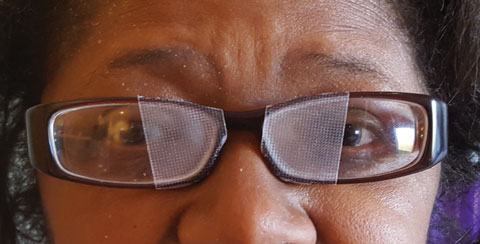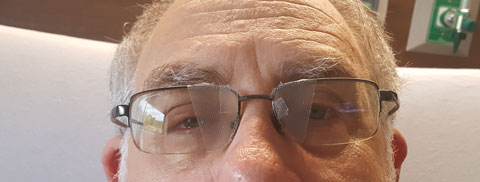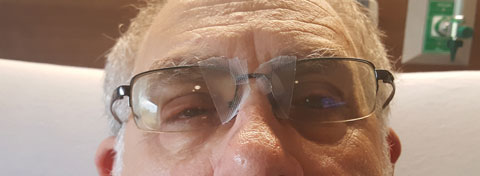 |
This is the fourth year we have been seeing patients onsite at several inpatient rehabilitation facilities. We started slowly and, with the support of Southern College of Optometry, grew the program annually. We now have a team of four doctors who see patients at several facilities, and we are busier than ever.
When we get the call to visit a patient in an inpatient rehabilitation facility, we never know what we are going to find when we walk in the room. Commonly, we encounter patients with field loss, visual inattention, diplopia or unexplained decreased vision. Our mission is to help the patient obtain clear, single binocular vision, which not only helps the patient, but also allows the doctors, therapists and even other patients to make the best use of their time while there.
Go-to Treatment
Binasal occlusion is a staple treatment for many patients. Investigators show it can be beneficial for patients with esotropia, non-strabismic functional vision problems and amblyopia.1 Research highlights binasal occlusion use in a patient with significant visual disturbances secondary to cerebral palsy, but little literature exists regarding its use for patients suffering a traumatic brain injury (TBI) or stroke.1 One study demonstrates symptom and visual function improvements in a TBI patient undergoing vision therapy and using base-in prism.3
Binsasal occlusion is a type of sector occlusion that blocks the nasal portion of each lens to some degree. The practitioner can use virtually any kind of tape, but we prefer to use Transpore tape (3M), as it is not opaque. Some light can pass through, which stimulates the retina and helps keep the patient alert and oriented. To account for convergence when viewing at a close distance, we always tilt the occlusion so there is a smaller amount on the lower portion of the lens.
Binsasal Occlusion for TBI
Traumatic brain injury (TBI) is a major cause of death and disability worldwide.4 The Centers for Disease Control estimates that TBIs account for 2.2 million emergency room visits, 280,000 hospitalizations and 50,000 deaths annually.5 Changes in function following a TBI can be widespread and impact every single organ system, including the visual system. Aside from the obvious ocular injuries, after a brain injury many patients are unable to deal with the level of visual information they are receiving. They may complain of balance issues, light sensitivity, a swimming sensation and blurry or funny looking vision, to name only a few visual symptoms. Binasal occlusion reduces the amount of incoming stimulation, particularly blocking parts of the image seen by both eyes. Remember, the visual system receives information from both eyes’ nasal visual field. In some TBI cases, the patient cannot process all of the data in real time, which results in the failure of the vision system to keep clear, single binocular vision. According to one study, “when the visual process is labored, the organization and integration of this portion of visual space may be the most demanding as far as maintaining comfortable and clear binocular, single vision. Modifying the input from the very core of this area may serve to relieve stress.”2 The following two cases demonstrate the benefit of binasal occlusion in the TBI population.
 |
| Fig. 1. Binasal occlusion helped this patient overcome a swimming sensation and get back to her rehabilitation following a stroke. |
Case 1
A 62-year-old black female with a history of four strokes in the past several years presented, following her most recent stroke, complaining of swimming vision when she moved her head. Her occupational therapist was having trouble getting her to balance well and said the patient preferred to be lying down or reclined in a chair. Both postures make rehabilitation problematic. The examination at the patient’s bedside showed slightly decreased visual acuity with her current glasses, an intermittent alternating exotropia of about eight to 10 prism diopters at near and poor fixation, to the extent that she had trouble localizing and touching a target using her vision. She knew an issue existed and was particularly disturbed by the swimming sensation.
As this was not a case of double vision, my first inclination was to try binasal occlusion (Figure 1). Upon placement, the patient felt markedly better. When placing the occlusion for the first time, it’s acceptable to guess the best location. We have the patient fixate on the practitioner’s nose and place the tape just nasal of the pupillary margin. Then, we have the patient relax and engage with the surroundings. Some patients need more occlusion, others less. It’s straightforward to remove and readjust the tape a few millimeters.
Since the patient was in the facility a few weeks, I stopped back to assess the treatment a few days later. While she was still suffering with balance issues, she was making progress, according to the therapist. I chose to leave the amount of occlusion in place for the time being and requested a follow up when she was transferred to outpatient care. She started vision therapy several weeks later and is showing wonderful progress every week. The occlusion was successfully removed at the start of the therapy process.
 |
| Fig. 2. Although binasal occlusion improved this patient’s vision, he felt it was more annoying than helpful. Click image to enlarge. |
 |
| Fig. 3. By reducing occlusion, we were able to eliminate the visual symptom without interrupting the patient’s vision. Click image to enlarge. |
Case 2
A 65-year-old white male presented with a complaint of swimming vision at distance and near following a recent stroke. He was having trouble reading and watching TV. The examination showed excellent visual acuity, no restriction in eye movements and accurate localization of hand-eye coordination.
We placed the binasal occlusion and observed noticeable relaxation in the patient’s body (Figure 2). He tried texting on his phone and looked at the TV’s closed captioning and said his vision was not perfect, but more tolerable. We followed up a few days later, and the patient felt the occlusion was blocking his vision and was more annoying than helpful. We reduced the amount of occlusion, with positive feedback from the patient (Figure 3). He was seen several days later at the college and reported the swimming sensation was gone. The occlusion was removed and he was given several basic eye movement activities to perform several times daily. At follow up a month later, he once again reported no symptoms and performed well on a visual efficiency and processing evaluation.
These cases highlight the immediate positive impact of binasal occlusion. This treatment need not be relegated to inpatient use, but can be of value to the patients in your chair. You will be surprised how often patients slip below the radar, if you ask them about concussion or stroke and the most common accompanying symptoms. You have a great opportunity to help your suffering patients—and all it takes is a little piece of tape.
| 1. Tassinari JD. Binasal occlusion. J Behav Optom. 1990;1:16-20. 2. Gallop S. A variation in the use of binasal occlsuion. J Behav Optom. 1998;9:31-5. 3. Proctor A. Traumatic brain injury and binasal occlusion. Optom Vis Devel. 2009;40:45-50. 4. Park E, Bell JD, Baker AJ. Traumatic brain injury: Can the consequences be stopped? Canadian Med Assoc J. 2008;178(9):1163-70. 5. Report to Congress on Traumatic Brain Injury Epidemiology and Rehabilitation. Centers for Disease Control and Prevention. www.cdc.gov/traumaticbraininjury/pdf/tbi_report_to_congress_epi_and_rehab_snapshot-a.pdf. Accessed March, 24 2017. |

